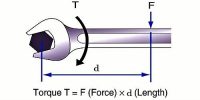Newton’s first law gives qualitative definition of force. Newton’s second law gives the equation for the measurement of force. From Newton’s second law we know the relationship between the force acting on a body and the acceleration produced due to this force. The law is as follows:
The rate of change of momentum of a body is proportional to the applied force acting on it and takes place in the direction in which the force acts.
Let a body of mass m is moving with an initial velocity u. Now a constant force F acts on the body for a time t in the direction of its velocity. Let the velocity of the body changed from 11 to v due to the application of the force.
Therefore,
the initial momentum of the body = mu
the final momentum of the body = mv
The change of momentum in time t = mv — mu
So, the rate of change of momentum,
(mv – mu)/t = ma [Since, acceleration, a = (v-u)/t ]
According to Newton’s second law of motion, the rate of change of momentum is proportional to the applied force.
i.e., ma ∞ F
= kF …. ….. (1)
Here, k is a constant of proportionality. To define the unit of force Newton consider k = 1. The unit of force is Newton (N). One newton (N) is defined as the force that will produce an acceleration of l ms-2 when it acts on a mass of 1 kg.
Thus if mass m is in kg, acceleration a is in ms-2, and force F is in N, then equation (1) becomes,
ma = 1.F
or F = ma
or Force = mass x acceleration
The dimension of force: [F] = MLT-2













